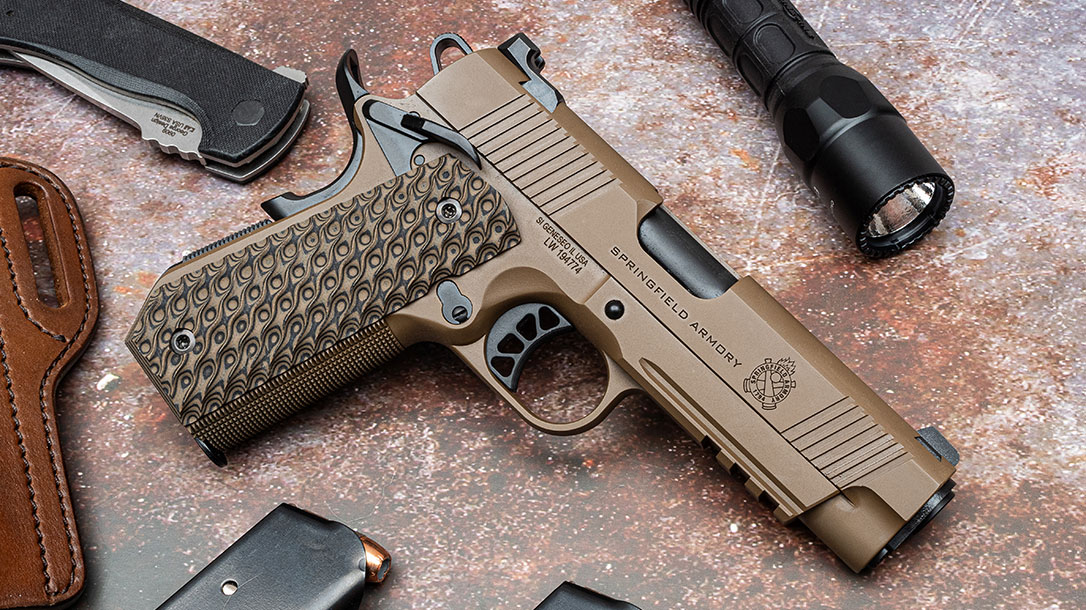Springfield Armory has recently introduced a wide variety of excellent firearms like the Hellion and the Echelon. Not to mention the new line of 2020-series bolt-action rifles. However, the company is still probably best known for its work with the 1911 platform over the decades. A solid example of Springfield making strides with the 1911 is its new TRP Carry Contour.
The Springfield Armory TRP Carry Contour
One of the company’s most popular 1911s is the TRP (Tactical Response Pistol). It was originally developed to offer some of the key features and benefits of Springfield’s Professional model at a lower price point.
Just this past January, Springfield Armory introduced a refreshed lineup of its TRP pistols. This included new features and different finishes from the original lineup. However, what was most intriguing about the TRP splash at the 2024 SHOT Show was the new TRP CC (Carry Contour) model.
Advertisement — Continue Reading Below
The TRP CC offers all of the great features and characteristics of the full-size TRP. But it does so in a lighter and more compact form factor for easier concealed carry.
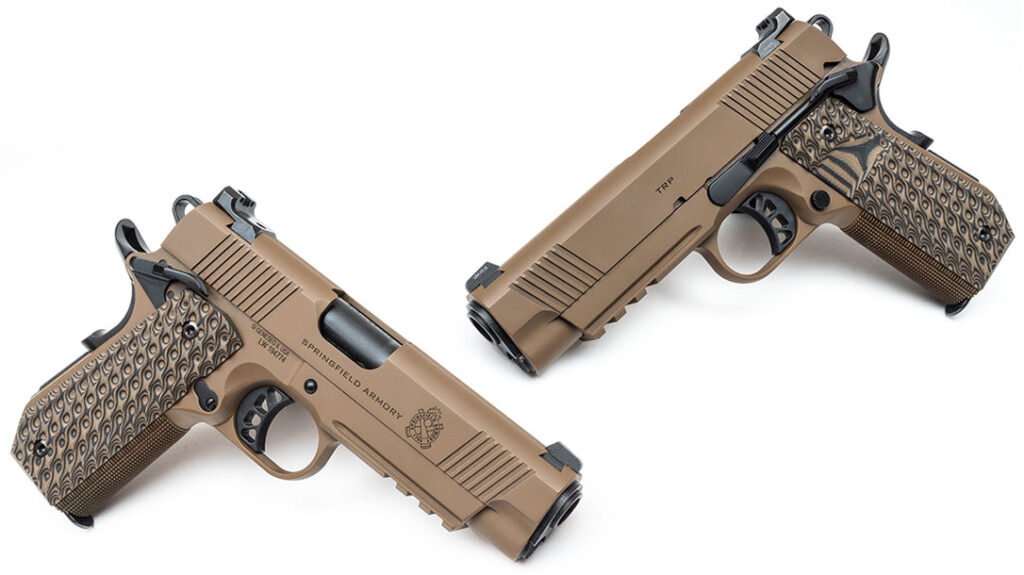
The TRP Difference
The TRP series sits in the middle ground between general production 1911s and full-blown custom 1911s like Springfield’s Professional model. And there are certain qualities found in the TRP that set it distinctly apart from a standard, mass-production 1911.
Advertisement — Continue Reading Below
The TRP lineup offers a set of enhanced features and more hand-fitting than a standard-production 1911. But not so much that it puts the pistol’s price out of the reach of most buyers.
The first feature of note is that rather than using a cast frame for the TRP, Springfield issues a forged frame to mate with a forged, carbon-steel slide. A forged frame is stronger than a cast frame. This is because the metal is compressed during processing to eliminate voids and gas pockets.
This results in a tighter and more uniform grain structure, which translates into higher strength. For the standard-size TRPs, the frame is made from carbon steel. However, the slightly smaller Carry Contour models integrate a forged aluminum frame for lighter weight and easier all-day carry.
Advertisement — Continue Reading Below
A second and closely related aspect of the TRP is that each frame and slide are hand-selected, matched, and numbered. This is so that they stay together throughout the manufacturing process. As a result, come tighter tolerances that reduce “slop” or excess play between the slide and frame. Not to mention, it typically results in a pistol that is more accurate.
Another “custom” treatment done to the TRP is the 20 line-per-inch checkering done to both the frontstrap and the backstrap. This is for both the sake of appearance and improved traction for better recoil control. Checkering like this is usually reserved for higher-end 1911s and is not often found on lower-cost models.
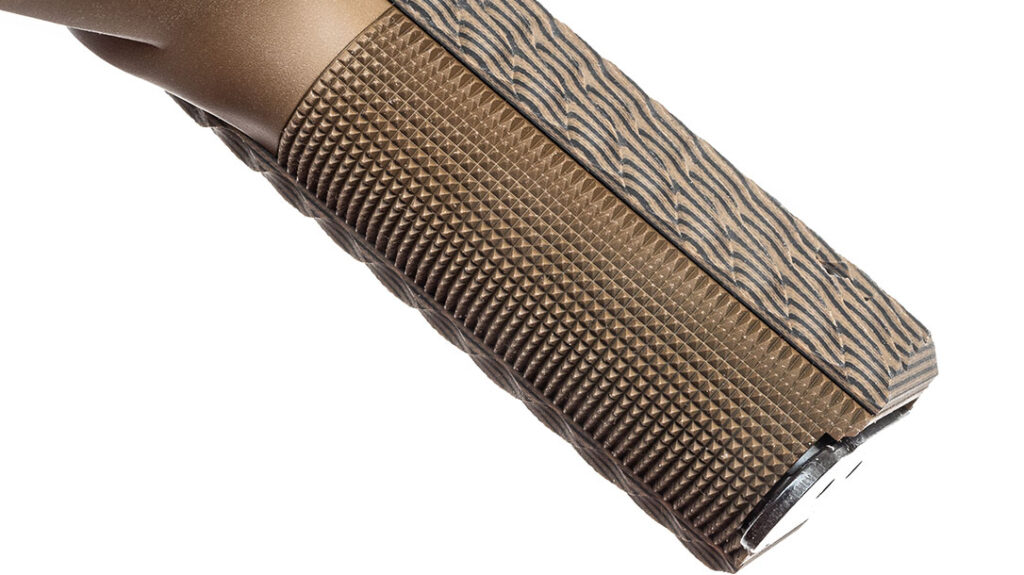
Advertisement — Continue Reading Below
Handling the TRP Carry Contour
The full-size TRP includes a two-piece magwell to facilitate quicker and easier reloads. However, the Carry Contour model, which we are covering in this review, forgoes the magwell. Instead, it includes a bobbed heel on the backstrap for the sake of better concealability and to mitigate any “printing” under a garment like a shirt.
All updated TRP models include an appropriately sized set of outstanding Hydra grip panels from VZ grips. Aside from being extremely attractive, the Hydra grips feature aggressive texturing for a rock-solid purchase on the pistol.
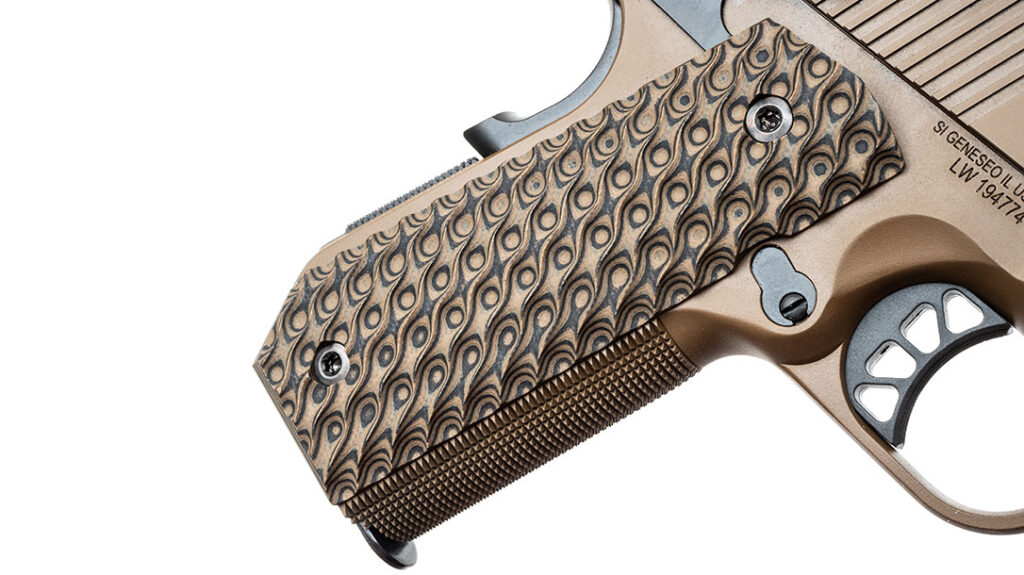
Advertisement — Continue Reading Below
Other inclusions found in the TRP Carry Contour (and full-size models) are an extended, ambidextrous thumb safety and a three-slot Picatinny rail for a light or laser unit. Up top, the newly updated TRP features a set of tactical, serrated sights. The sights include a tritium insert up front and two tritium inserts at the rear.
The Carry Contour includes a Commander-style recoil system versus the full-length guide rod arrangement for the full-size TRP model. A final custom touch is the set of serrations that adorn the top of the slide. This improves visual appeal and mitigates any glare that might interfere with sight acquisition.
Common aspects that can be found in both the full-size TRP and the Carry Contour version are that each version is available in either black or Coyote brown. Likewise, all TRP pistols include a stainless-steel, cold-hammer-forged barrel that offers longer life and better accuracy retention.
Advertisement — Continue Reading Below
Additionally, each TRP pistol includes Springfield’s Gen2 speed trigger, an expertly applied Cerakote finish, and front and rear cocking serrations for easy slide manipulation. Each full-size model ships with three 8-round magazines. However, each Carry Contour model ships with three 7-round magazines—again for the sake of concealability.
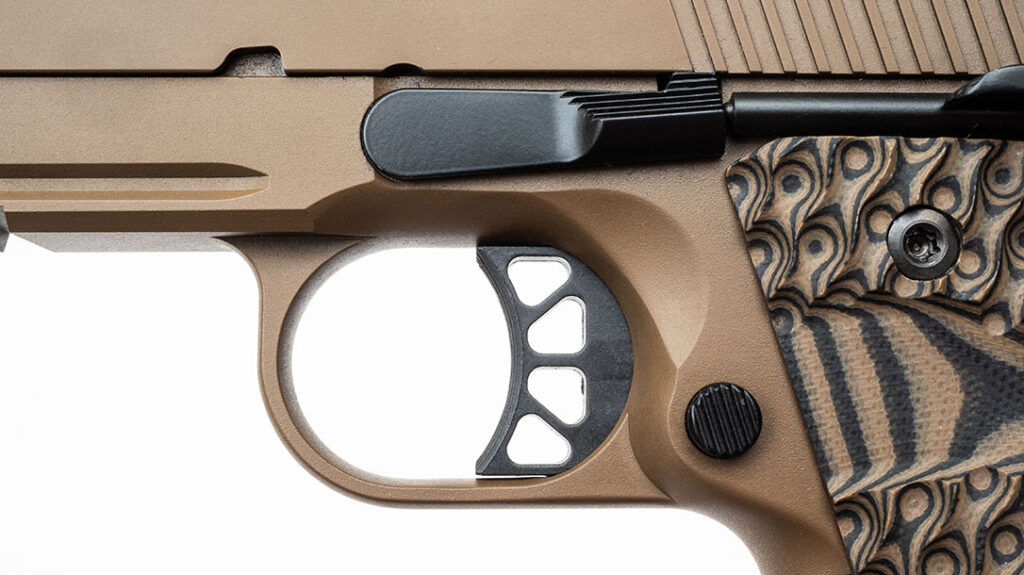
The Carry Contour Experience
Lugging around an all-steel, full-size 1911 on your hip can get downright uncomfortable after a full day of carry. Not to mention the issue of trying to completely conceal a full-size 1911 under a shirt or other garment. Especially without the grip printing and alerting others of your concealed-carry status.
Advertisement — Continue Reading Below
The new TRP Carry Contour model was designed to help with both of these concerns. First, the pistol has a shorter, Commander-length frame. And, since the grip is the hardest part of a pistol to conceal, Springfield fashioned a Carry Contour cut on the heel of the frame to mitigate any printing issues.
To help with the weight problem, the TRP CC makes use of an aluminum frame instead of a steel frame. Combining the aluminum frame with a shorter-length slide results in an overall weight of 27.3 ounces.
This greatly improves the all-day carry experience. However, there’s a tradeoff in felt recoil when shooting a smaller and lighter pistol with God’s caliber of .45 ACP. And that’s what we wanted to try out when we took the TRP CC for a day at the range.
Advertisement — Continue Reading Below
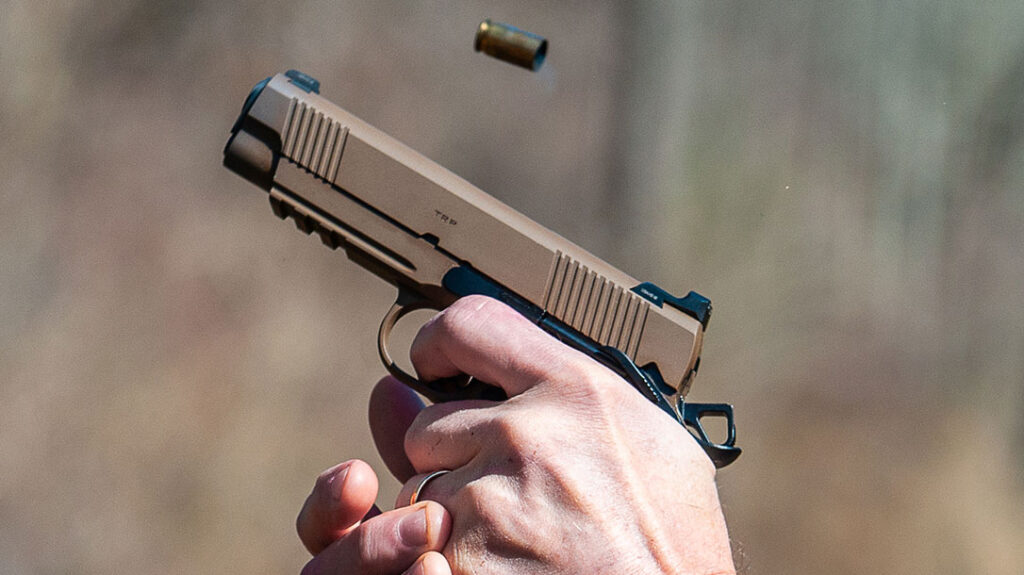
Shooting the TRP
During our testing, we used a good assortment of .45 ACP ammunition from Federal Premium, Sig Sauer, and Hornady. Everything from range loads to premium hollowpoints. Just for good measure, we even threw in a couple of +P loads.
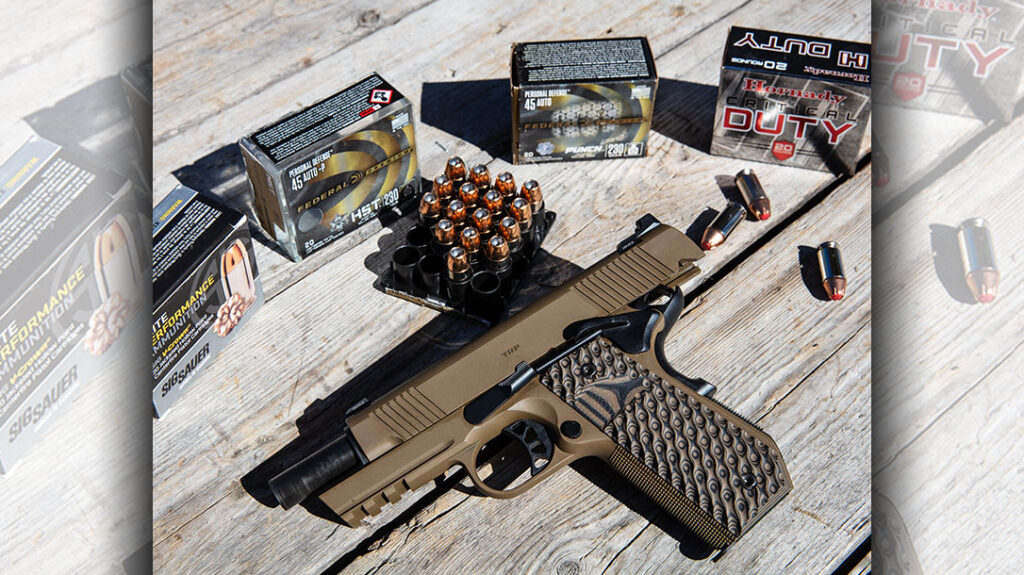
As expected, the recoil with the lightweight frame and standard loads was stout but manageable. This is largely thanks to the control afforded by the excellent texturing on the grips and the 20 LPI checkering on the frame. However, that sword cuts both ways.
When shooting Hornady’s 220-grain +P Critical Duty loads, the felt recoil increased significantly. The practiced individual can still manage that recoil. But after a few magazines worth, we really started to feel some discomfort from the highly textured grip slabs.
The Critical Duty load would be an excellent choice for defensive use. However, it’s not one that you’re going to want to shoot a lot of at the range. Especially with that light frame and those aggressive grips.
Oddly enough, the felt recoil of Federal’s 230-grain +P Personal Defense HST was very mild by comparison. I’m not sure what was going on with the lot I had on hand, but it didn’t recoil like a +P load. And it didn’t attain anywhere close to the factory-listed velocity.
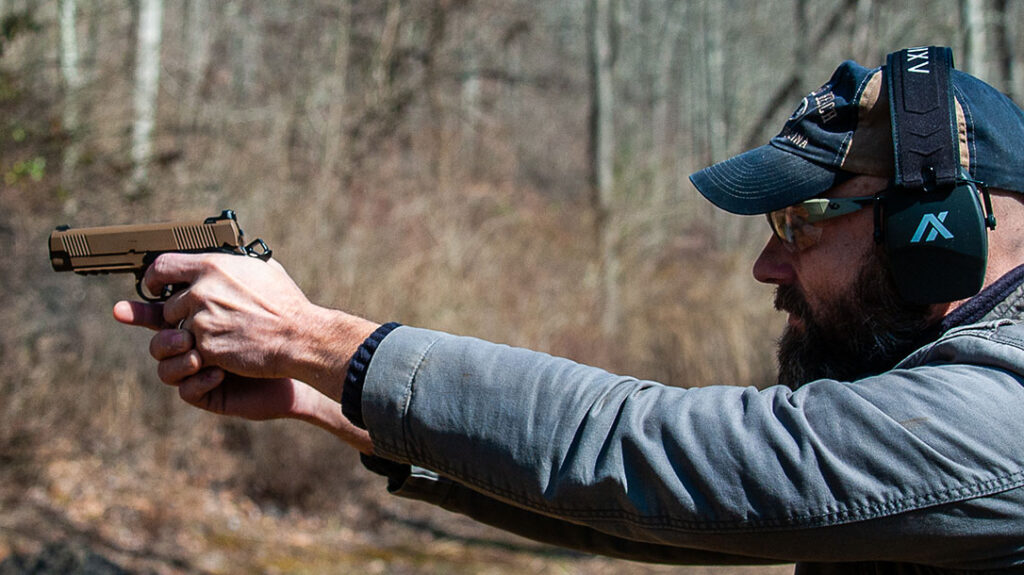
Federal claims a velocity of 950 fps, but I measured an average of 770 fps at 15 feet. It could have just been a one-off thing with the batch I had. However, I’d like to try a different lot to see what results I get.
Stellar Accuracy
Where the +P HST load excelled was with accuracy. Shot from a standard rest at 15 yards (for the mid-size barrel), the HST load had the single best group of .75 inches. Likewise, it produced a best average group size of 1.03 inches. Those were excellent results. But if you look at the table (below), the TRP CC exhibited fantastic accuracy with all of the premium loads we tested.
Each load we tried had a three-group average size of less than 1.25 inches. So, the good news there is that it’s pretty much dealer’s choice when it comes to picking a defensive load. The TRP CC shot all of them extremely well.
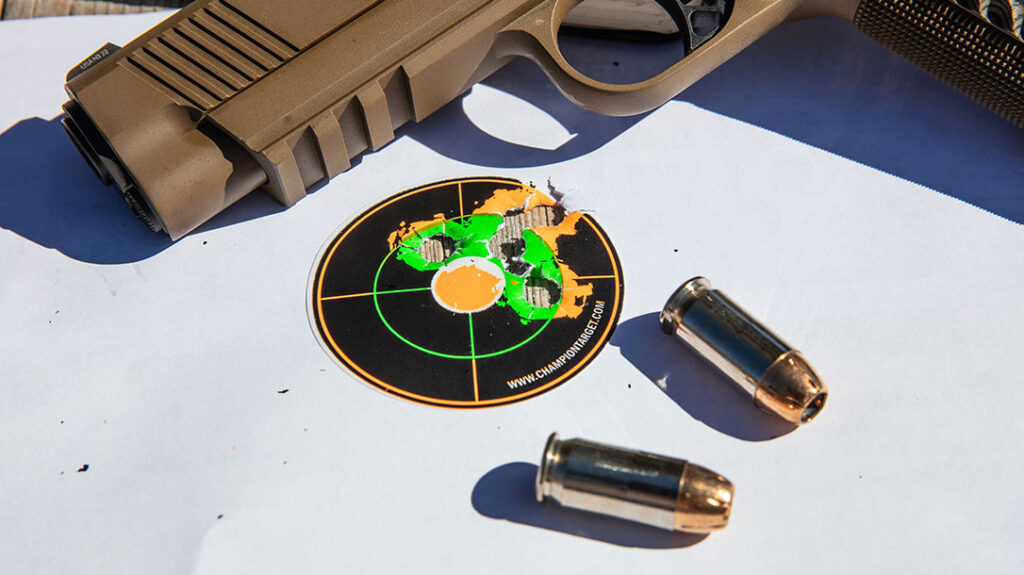
Part of what contributed to the TRP CC’s stellar accuracy, aside from the tight fit of the parts, was the relatively light and crisp action of the Gen2 Speed Trigger. A benefit of the 1911 SAO operating system, the TRP CC’s trigger broke at an average of 4.75 pounds.
It may not be the lightest trigger I’ve tried on a 1911. However, I think that’s in the range of the ideal break weight for a 1911 that’s going to be used in a defensive capacity. Even better, the reset was incredibly short—almost instantaneous—affording us extra-quick follow-up shots on target.
Running the TRP Carry Contour
Similarly, other controls and parts of the TRP CC were assembled with that same level of care. The extended, ambidextrous thumb safety was easy to reach and engage. Correspondingly, it offered a very positive action, snapping on and off safe with real authority and no mush.
The iron sights are a tactical arrangement with the tritium inserts and a shelf on the rear sight. This allows you to cycle the slide off a table, belt, or boot heel. My personal preference would have been for some sort of high-visibility rings around the tritium inserts. That would have provided easier pickup and faster alignment on target.
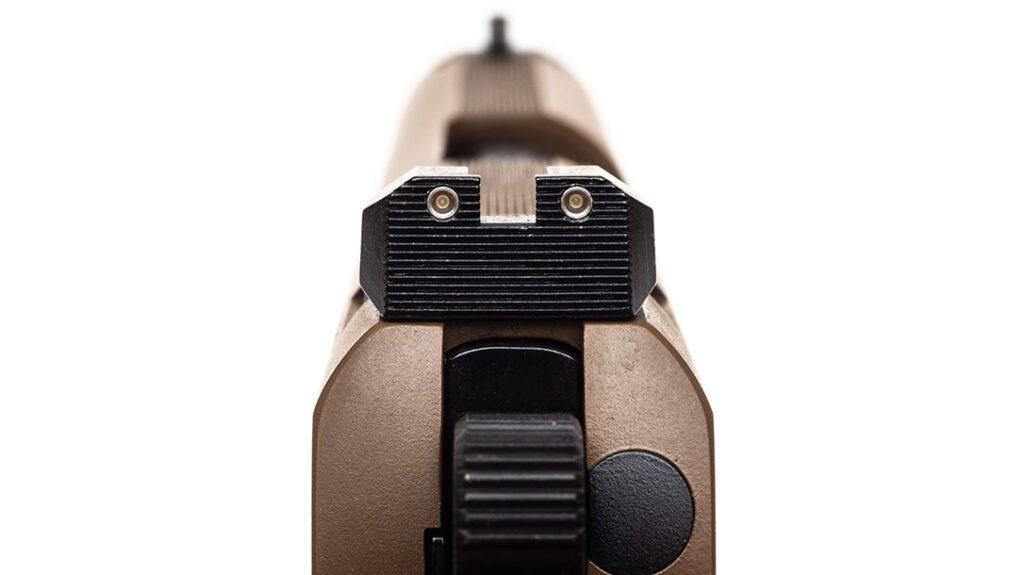
During the rest of our testing, doing drills and just cycling as much ammo as we could through the TRP CC, there were zero issues with reliability. Despite the extra-tight fit of the various parts, the TRP CC had no problems cycling through a good assortment of brands and types of quality ammunition. This includes the Flex-Tip Critical Duty loads that, while offering outstanding terminal performance, can sometimes trip up some other pistols.
A Different Path
It seems like high-capacity, polymer-framed, and striker-fired 9mm pistols are the obvious answer to today’s average shooter’s EDC needs. It takes a dedicated pistolero to master the craft of rocking a 1911. Particularly a lighter and more compact model like the TRP CC that dishes out more recoil than a standard model.
Yet, with a little time devoted to training comes reward. Specifically the experience of owning and deploying one of the most efficient, effective, and beautiful platforms ever conceived in the realm of fighting handguns.
At an MSRP of $1,999, the TRP CC certainly isn’t inexpensive. However, it serves up features and characteristics of custom 1911s that are usually out of the reach of most buyers. And it does it well.
In short, it’s the gateway pistol, bridging the divide by delivering performance, build quality, and style without busting the bank. And I’ll venture to say that once you try it, you will never be satisfied with a mass-production 1911 again.
For more information, please visit SpringfieldArmory.com.
Springfield Armory TRP Carry Contour Specs
| Caliber | .45 ACP |
| Barrel | 4.25 inches |
| Overall Length | 27.3 inches |
| Height | 5.5 inches |
| Width | 1.25 inches |
| Weight | 27.3 ounces |
| Grips | Hydra G-10 VZ Grips |
| Sights | Serrated, Tritium Inserts |
| Action | Single Action Only |
| Finish | Cerakote |
| Capacity | 7+1 |
| MSRP | $1,999.00 |
Performance
| Accuracy | |||
| Velocity | Average | Best | |
| Federal 230gr. Punch | 830 | 1.21 | .88 |
| Federal Personal Defense 230gr. +P HST | 772 | 1.03 | .75 |
| Hornady 220gr. +P Critical Duty | 1008 | 1.19 | 1.06 |
| Sig Sauer 230gr. Elite V-Crown | 844 | 1.16 | 1.13 |
Bullet weight measured in grains, velocity in feet per second 15 feet from the muzzle by a Competition Electronics ProChrono Digital Chronograph, and accuracy in inches for three, five-shot groups at 15 yards.
